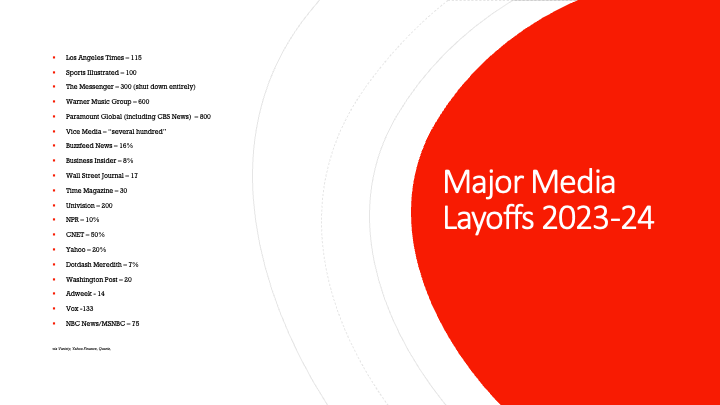The media landscape is changing.
It’s been happening gradually over the years – and now there’s no denying it.
A staggering number of journalists are being laid off. Entire publications are shuttering.

This image offers a snapshot of some larger media layoffs over the past 18 months. The numbers don’t lie.
As a journalism enthusiast – and someone with a degree in Journalism – seeing the media landscape in decline is painful.
But if you want to leverage public relations to help increase your company’s visibility, all is not lost.
The question now is: How can B2B companies and small businesses move forward to secure earned media coverage in this uncertain environment?
12 PR Ideas to Help Companies Move Forward with Their Earned Media Efforts
Landing articles about your business can be a struggle, but some approaches may be more effective than others in the current climate.
What works in these challenging media conditions as companies try to secure earned media coverage?
We may need to think outside the box and find a roundabout way to gain attention. Let’s look at some scrappy PR ideas that can still work to help small businesses get news and stories out there.
1) Focusing on Trade Media: With B2B clients, trade media has always been a mainstay.
What is trade media, or trade press, as it is sometimes called? These media outlets target a specific audience of those working in a particular industry or trade.
As mainstream media outlets dwindle, focusing on publications in your industry can be an effective method of securing coverage for your brand. Beyond that, media coverage in the trade press is often more likely to be seen by prospects, as they tend to turn to industry publications they trust.
If you’re unaware of which trade publications your audience follows, do some research online (or hire a PR consultant to help). Or, ask customers where they’re turning for information.
Bonus: These publications often accept contributed articles, which help position executives as thought leaders in the company’s space.
2) Self-Publishing Your Content: Now more than ever, companies should focus on developing trust with their audiences. As the use of AI increases, audiences are becoming increasingly skeptical and may wonder, “Was what I’m reading generated by AI?”
In an era where fake news is becoming easier to generate because of AI, a company speaking in its own words could not be more vital.
Self-publishing owned content like thought leadership, customer stories, and press releases on a company’s site is one way to build trust and control the narrative. This can be an important component of a brand’s reputation management program.
Publishing content on the brand’s site is also effective for search, meaning it may come up when a journalist searches for a source.
Further, once the content is published, it can be shared on social media. Repurpose content even further by pitching pieces that are a fit to trade publications that accept contributed articles.
Another way to self-publish is to start a newsletter. Email is one of the most effective ways to market a business today, and a newsletter gives B2B brands yet another avenue to publish their news and stories. And – you never know who your newsletter might be forwarded to.
3) Content Repurposing: To piggyback on the point above, repurposing content is a wise strategy. A study conducted in 2022 says that each piece of B2B content costs nearly $3K to create. I’m sure that number has only increased. That can add up quickly, especially for a small B2B company.
Why not make the most of it by trying to squeeze more from each piece? Pitching it to a trade publication helps it get more visibility. The published thought leadership article or customer story can then be shared on social media.
4) Leveraging C-Suite Executives: Get your executives involved in your B2B PR efforts. Some research suggests that putting executives out in the public eye more often can also help boost a brand’s visibility. This could include scheduling more media interviews for them, placing them as event speakers, or having them post and comment on social media.
In fact, there’s often a direct correlation between the CEO’s media visibility and corporate visibility — both of which can significantly influence business outcomes, this Axios article says.
One of my favorite examples of a brand leveraging its CEO to bolster its PR efforts is Land O’Lakes. Kim Olson, the company’s chief communications officer, often talks about how the company’s CEO, Beth Ford, is a “communicator’s dream” because she makes herself available for media interviews. Of course, having a CEO who believes in the value of PR AND is skilled at media interviews makes a huge difference in the success of any PR push.
Beyond participating in media interviews, encourage your C-Suite executives to speak at industry events or post and comment on social media posts.
“Commenting on trends and news of the day allows executives to appear as thought leaders while also weaving in strategic, corporate messaging,” the Axios piece goes on to say.
5) Commenting on Social Media Posts: To expand further on the point above about executives commenting on social media posts, factor social media commentary into your strategic communications plan.
“As you consider adding comments to your PR plan, think about leaving thoughtful and insightful comments on three to five daily posts,” says Gini Dietrich of Spin Sucks in this article. “This will work for reporters, influencers, bloggers, potential partners, and even potential customers.”
Looking at LinkedIn as an example, many comments there seem to fall into a few buckets. They’re either clearly AI-generated, self-promotional, or say nothing of value. This makes it easy to stand out with a bit of time and effort.
If you don’t have the time, you can hire a PR consultant to help – although I saw that some agencies charge up to $1,000 per post – eek. The point here is that if commenting on social media posts is part of your strategy, be sure to put some thought into it.
6) Incorporating Paid Media: If budget allows, including some paid media in the form of sponsored content or ads may help garner more attention on the earned side. As publications struggle, they may be inclined to pay more attention to companies willing to spend some of their marketing budget on the paid side.
7) Leveraging Industry Associations: To get in front of others in your space, industry associations can be beneficial. Consider joining those that are the best fit as a paid corporate member.
If your company is a paying member, they’re more likely to publish your announcements in their newsletters, which are usually read by your fellow members (= prospective customers).
And, encourage executives to volunteer to sit on association boards. This can garner additional visibility for them as well as for the company.
8) Investing in Trade Shows: Believe it or not, trade shows are back in a big way in some industries. A client in the food manufacturing space says that the recent shows in their industry have garnered record attendance.
If your brand has the budget to participate, there are numerous ways to leverage trade show participation from a PR perspective. From booking meetings with the press attending the show, to placing your executives in speaking slots, to submitting your new products for coverage, and posting about ALL of it on social media, these are just a few PR ideas.
9) Posting on Social Media: Of course, we know that posting company news and stories on social media can help gain visibility. Sometimes, posting there can even draw a reporter’s eye.
My advice to clients regarding social media is not to spread themselves too thin. Choose the platforms carefully. The first question to ask is – “Where is our audience spending time?” Unsure? Do some research to find out.
Pick one or two social media platforms to focus on, then post and engage consistently. For B2B companies, LinkedIn should be at the top of the list.
10) Following Journalists on LinkedIn: For B2B companies in particular, paying attention to journalists on LinkedIn can yield results. More journalists are spending time there as Twitter/X continues to decline. Some even post about the stories they’re working on, seeking sources.
11) Connecting with Journalists via Their Newsletters: Many journalists now publish their own newsletters. If you’re reaching out to journalists and not having any luck, try subscribing to those. That can shed light on what they’re writing about (some even share what stories they’re currently sourcing for) and provide an “in” that others may not be thinking about.
12) Meeting with Industry Analysts: I was chatting with someone recently about industry analysts. We both remember going on analyst “tours,” meaning we’d fly to the East Coast and visit industry analysts at their Boston and New York offices.
While in-person tours may not be as common now, companies can schedule virtual meetings with analysts. What’s the value of this? For one thing, you’ll probably get beneficial feedback on whatever you share with them. And, journalists often call on analysts for quotes for stories they may be working on. So, if an analyst thinks your product or solution is worthwhile, they may talk about it. Lastly, analysts publish newsletters, too, so they may cover your company there.
Analysts often take the first meeting for free, so even though they may try to sell you their services, it can be worth exploring.
Try These Public Relations Approaches to Get More Media Coverage
As the media landscape continues to evolve, we may have to get creative and try different approaches to get the results we’re looking for.
Give these PR ideas a try if you find yourself struggling to get your company in the news.
Looking for a public relations consulting firm to help with your PR planning? If you’re a B2B company looking to launch or expand your PR program, let’s chat. Learn more about my PR consulting services here. Book a no-obligation call to talk about your needs here.
About the author: Michelle Garrett is a B2B PR consultant and author of B2B PR That Gets Results. She helps companies create content, earn media coverage, and position themselves as thought leaders in their industry. Michelle’s articles have been featured in Entrepreneur, Muck Rack and Ragan’s PR Daily, among others. She’s a frequent speaker on public relations and content. Michelle has been repeatedly ranked among the top ten most influential PR professionals.
100% of this blog post was written by me, the human.
Featured image: Miguel Á. Padriñán

